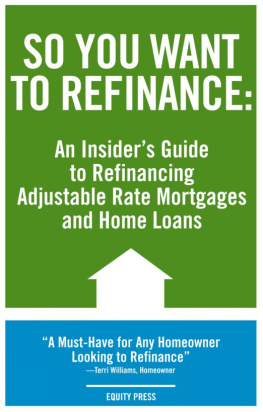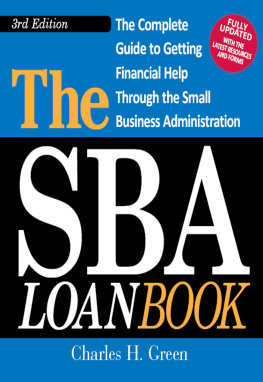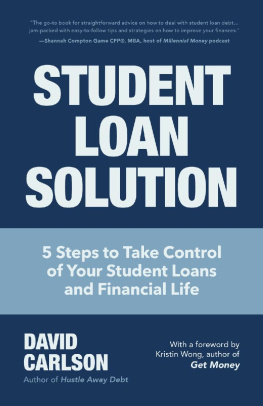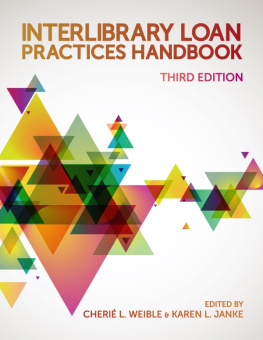I n this book I hope to give you a start-to-finish overview of what happens during a mortgage loan application and explain the process. From purchase to refinance, from construction loan to rehab loan, from Conventional to FHA all the way to VA loans and everything in between. My hope here is that you will see where you are in the process and be able to follow along fairly easily without much effort and know what to expect as we progress through to completion.
It is filled with real life stories of what Ive experienced in my 30+ years in the finance industry. Some of it is quite comical and entertaining, some has hard lessons to share, but most of all its a real honest look at the good parts of lending, the bad parts youll encounter, and the ugly stuff in between that gets the deal done. I have wanted to write this for a while, and there never seems to be an end to the new content that I discover. Please feel free to pass on to those you think may also benefit. Looking forward to working with you and those you refer. My gift to youplease enjoy!
Chapter 1:
The Mortgage Loan Process. The Good, Bad, and Ugly, but the Real
C ongratulations! So you want to buy a house...or refinance your house...or get a rehab loan...or a construction loan. Youve done the hard part, which is the choice to apply. This book is designed to help you know the steps all the way through the mortgage process , not just the real estate side. Im trying to give you a realistic pathnot just the ideal but, along with the good, the bad and the ugly that can and often happens, along with why it does.
Youll see thousands of books out there about the Real Estate industry and all the ins and outs of buying a home, but they just lightly cover the mortgage side itself and they leave out major things that happen. In this book I want to give you a real, clear picture of the process in its entirety along with the whys so you can understand the other side of the coin.the investor who put the money up for you to borrow in the first place.
What if that were you? What would you want to know? How careful would you be if you were going to put thousands of your hard-earned money up for investment? Would you want all of it back and with interest? Of course, so lets look closer.
In the very big picture, the money all goes in a big circlethe investor buys an investment instrument in the form of a bond, for example, with the expectation of getting it all back plus interest. The homeowner is at the other side of the circle and wants to borrow the money for their home. The money moves through insurance and investment companies and banks to accomplish thisthe other parts of the circle. In other words, its not always the big bad banks who lend money, but its also grandmas, families, and companies who put those dollars up for investment.
I want to keep this part very basic because it can easily get overwhelming. Insurance companies collect millions in premiumsyou pay those for your car or home owners insurance nowthose dollars need a place to go, so they invest (buy) the bundles of mortgage loans in the form of investment vehicles and the cycle begins again.
Sometimes banks will portfolio or hold on to a loan vs. sell it to the secondary market, but that is rare. They are only making money when they make new loans so they dont want their own money tied up. (More on that in The Circle of Money chapter.) The main thing to remember is that you are obligated to make a monthly minimum payment by the due date, regardless of who your loan is sold to .
I have a story on the reasons why in the chapter about Loan Types: FHA, VA, CONV, USDA, ARM, etc. that will drive this point home. Paper trail everything so you are ensured proper credit, especially during this time window of the loan being sold to another lender. Keep copies of all correspondence from each lender, the old and the new, along with your canceled checks and who they were paid to.
If you make payments to the wrong bank but you did generate a payment every month and have record of it, then the two banks can reconcile. This will protect you and your credit in case the banks make a mistake during the transition.
There are independent companies hired to give a rating on the bond/investments, such as AAA or AA and so forth, meaning how safe they are as an investment. The idea here is transparency. As you recall from the crash in 2008, all the bonds were getting AAA rating even though they were nowhere near that quality, meaning that the risk of default level on those mortgages was much higher than expected.
I could go on for days about the crash and the havoc that unnecessary greed and ignorance cost our nation, but lets instead zoom down to you at a local level, now that we see a snapshot of where you are in the big picture.
The items you will need and reasons for those items can be found in a checklist I have created for you (attached below in a few pages). Its very thorough with a slight sarcastic and humorous tone because of the redundancies sometimes in my industry. Its all in good fun though. I understand both sides: why the bank needs these things and the consumer complaint about the same things over and over, so you are not alone. Most of the time I would agree with you. The biggest question I always hear is, Is that all you need? My answer is simply, At this time, yes, but overall, no. There will always be things I need all the way up until after youve signed escrow.
So be ready and be continuously providing reoccurring items such as pay stubs, bank statements, and tax returns if we are nearing April, and always be ready to be signing another document. This is the way the industry currently is.
There are typically over 30 people involved in one transaction, up to 60 or so depending on what the transaction is. Everyone from your home inspector, pest inspector, other real estate agent, appraiser, title and escrow officers, set up clerks, managers, underwriters, processors, etc., all the way to the courier who drives the hard copy of original signed documents (unless youre doing digital signatures).
I have two stories about couriers that cost time on a file. One had his car catch on fire on the I-5 freeway. Laugh, but that really happened! He was okayand so were the files, thankfully. Another time, the courier carrying hard copies of signed original documents locked himself out of his car! These are great stories and examples of what can happen that cause delays. I have a lot more to share with you. I think it will be a fun book to write and Im looking forward to it.
See the enclosed checklist that I have created its four parts and helps describe the reasons behind the requests. I hope to help make the process easier!
Part 1 of 4: Welcome Letter, Checklist for Loan Application, and Detail of the Process Guide
My Commitment to you - First of all, thank you for applying for a loan. I look forward to helping you even if it means we do not do a loan, if it doesnt improve your financial position at this time. As you know, there are many changes being implemented to improve the volatile lending industry. My commitment to you is improving your current situation. That means if for some reason the loans available dont do that, then well wait until something is available that does improve your situation.












